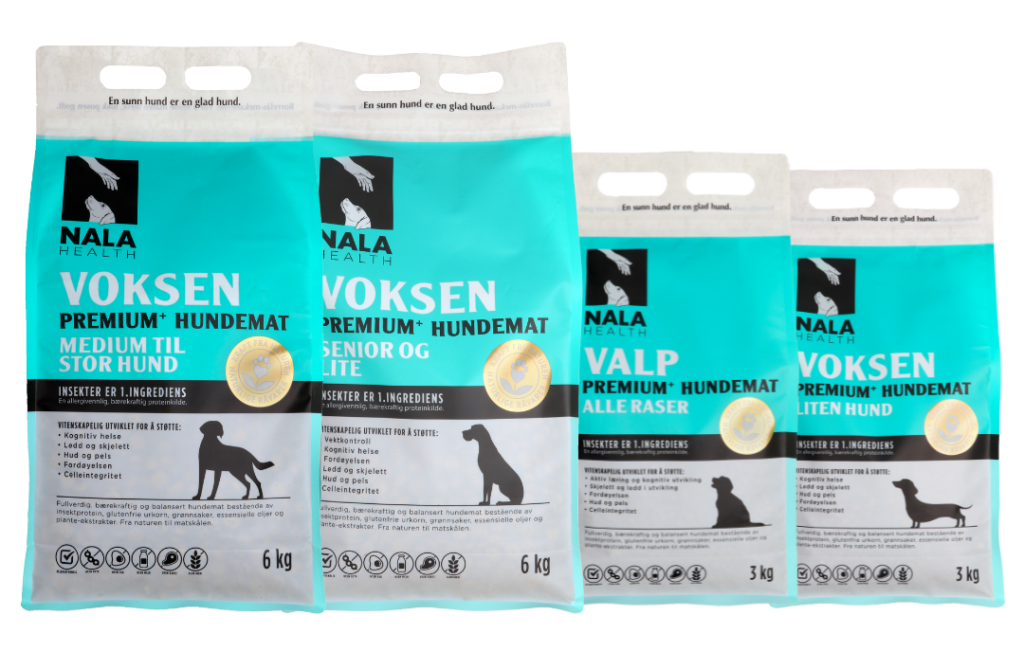When to switch to adult dog food
 Synne Hemsen Berg
Synne Hemsen Berg
A puppy needs more protein and fats compared to adult and senior dogs. In addition to this, they need specific vitamins and minerals that support a growing skeleton and curious brain. Calcium, phosphorus, vitamin D and Omega 3 support joint health and overall skeletal development. DHA omega 3 contributes to concentration, attention and memory. DHA Omega 3 is an important nutrient for growing puppies’ brains. A balanced diet early in your dog’s life builds the foundation for a strong and healthy dog.
Your dog’s nutritional needs will change throughout the various life stages from puppy to senior. This is why feeding your dog food formulated for their life stage is important. When you should switch to adult dog food depends on the dog’s breed, size and development.

Nala Health provides balanced nutrition and optimal health from puppy to senior
Breed
Your dog’s breed and expected mature body weight will determine at what age your puppy has reached adulthood. Smaller dog breeds are considered adults at an earlier age than large breeds, who take longer to mature. A guide to when various breed sizes are mature:
- Toy breeds are fully grown at about 9 months old.
- Small dog breeds are considered adults once they are 9-12 months old.
- Medium dog breeds reach young adulthood when they are 12-14 months old.
- Large dog breeds become adults when they are between 15-18 months old.
- Giant dog breeds reach adulthood at the age of 18-24 months.

Expected adult weight
Your dog’s expected adult weight prompts you to when you should switch to adult dog food. When your puppy is close to the average weight for its breed, it’s time to consider changing their food. Because puppy food contains more calories than adult dog food, you may notice some weight gain once your dog has reached their adult weight. This weight gain is a prompt for you to switch to adult food. A general guideline is:
- Toy breeds weigh between 3.5 and 6kg
- Small dog breeds weigh between 6 and 10kg
- Medium dog breeds weigh between 10 and 20kg
- Large dog breeds weigh between 20 and 40kg
- Giant dog breeds weigh between 50 and 75kg
Your puppy’s nutritional needs
Feeding from 8-12 weeks
The best food for your puppy during the first 8 weeks is milk from their mom. This is one of the reasons you should not take a puppy home with you before they are 8 weeks old.
The first production of breast milk is called colostrum which contains a high concentration of vital nutrients, contributing antibodies and good bacteria to the gut. Colostrum is an essential contributor to your puppy’s immune system and overall health.
Some solid food/puppy food can be introduced with breast milk at about 4 weeks of age. The breeder will make a porride with the kibble for the puppies in the beginning. After 8 weeks, the puppies can leave their mother and transition completely to puppy food.

Feeding between 3–6 months
During this period, the puppy should have 3 to 4 small meals of puppy food per day. Determine their daily nutritional needs on the feeding table on the dog food bag and divide this evenly over the 3 or 4 meals. Note that your puppy’s daily requirements will increase monthly for the first 6 to 8 months, during which your dog grows the fastest.
To add some variety to their diet you can mix in some lightly steamed vegetables, bone broth, blueberries, fish and so on. 1 tablespoon of natural, organic yoghurt two to three times a week before breakfast is good for gut health and their teeth. You can do this throughout your dog’s life. Some foods are toxic to dogs so beware not to add these to their diet.
Feeding from 6–12 months
Your puppy can now have 2 meals per day. Keep an eye on their daily requirements, as their portion size will increase every second month until they are about 8 months old. Then their meal size will decrease a bit again.
After about 12 months
When your dog reaches its adult weight, you can continue with two meals per day with adult dog food. Choose a complete, balanced and high-quality adult dog food to provide your adult dog with the nutrition they need. Transition over to adult dog food over 7 days – see below.
How to switch from puppy food to adult food?
A gradual transition from puppy to adult food makes the process smooth and comfortable for your dog. A rapid transition can cause stomach pain, vomiting and diarrhoea. Spend a week mixing and increasing the amount of adult food with the puppy food switching completely to adult dog food by day 7. If your dog has a sensitive stomach, you can transition over a longer period.

Looking at your dog’s age, weight and breed can give you an idea of when to switch from puppy food to adult food. It is better to let your dog eat puppy food for a bit longer than to transition them too early. You can consult with your vet so that they can also guide you to time the transition well.

